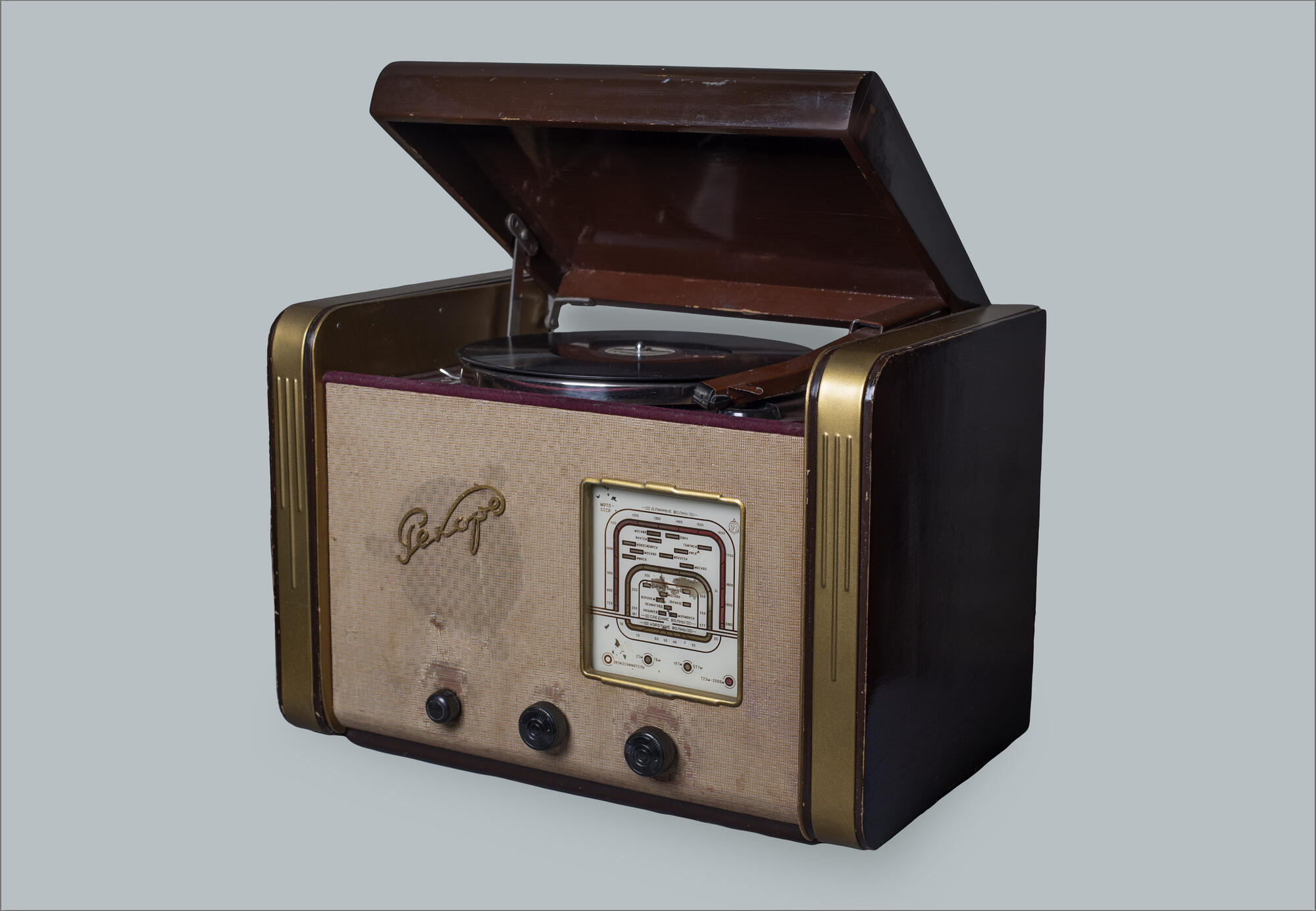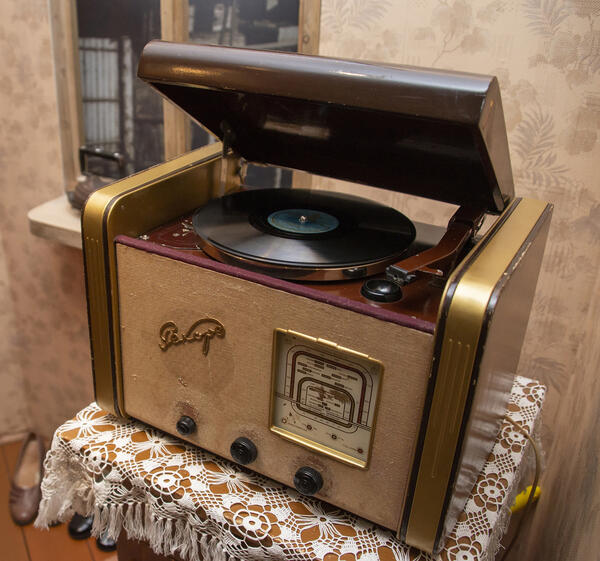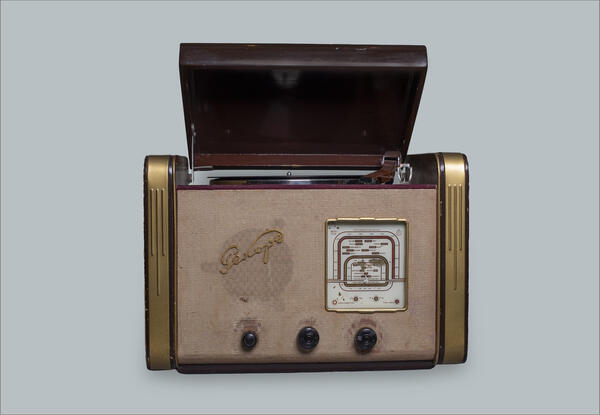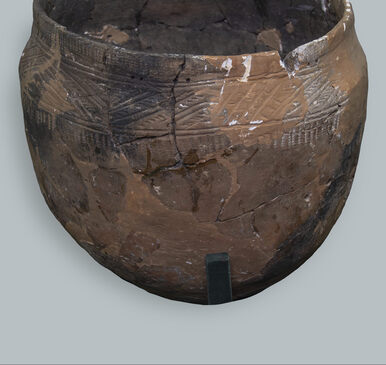A radio-phonograph is a tabletop radio device for home use, combining the functions of a radio receiver and a vinyl record player. The “Record” brand was one of the best known in the Soviet Union. Its products were inexpensive and were steadily produced in large runs from 1945 until the late 1970s.
Production of radio receivers was established in Irkutsk and Berdsk. The Berdsk Radio Factory was founded in 1946 on the basis of the Kharkov radio factory named after F.E. Dzerzhinsky. It was evacuated to Novosibirsk Region during the Great Patriotic War. The first batch of “Record-46” radios was produced in September 1946, followed by other, more advanced models. The “Record-53” (1953) was an upgraded version of the “Record-52”, differing externally and partially internally: the loudspeaker and low-frequency part of the circuit were replaced.
There are three knobs on the front panel. The left one was used to switch on the AC power and to adjust the volume. The middle one was for tuning. The right-hand knob was used to switch bands (short-, medium- and long-wave) and also to switch the unit into a phonograph mode.
An important feature of the “Record-53” was its ability to play both regular and long-playing records. In the latter case, the corundum needle had to be replaced: they were made with a smaller radius of curvature for long-playing records.
In 1985, the Berdsk Radio Factory was transformed into the Industrial Association “Vega”, the parent enterprise of the Soviet radio industry. In 1998, the company was declared bankrupt and removed from the registers a year later.
The model of this radio was identified by its external features: the opening lid, the front side covered with a light brown cloth and fitted with a metal plaque “Record”. This item belonged to Grigory Romanovich Popov.
Grigory Romanovich (1923–1984) was born in the small settlement of Chasovnya in the Dudinka district of Taimyr and entered the Hertzen Pedagogical Institute in Leningrad but was drafted to the front almost at once. He was awarded orders and medals for his military service. After the war, he graduated from the Hertzen Institute in Leningrad and then completed postgraduate studies at the Leningrad State University named after A. A. Zhdanov; his PhD thesis was devoted to the economic and geographical description of the Taimyr National District. He worked as a senior researcher, and later as the Scientific Secretary of the Council of the North in Yamal, Taimyr, Evenkia, and Moscow.
Production of radio receivers was established in Irkutsk and Berdsk. The Berdsk Radio Factory was founded in 1946 on the basis of the Kharkov radio factory named after F.E. Dzerzhinsky. It was evacuated to Novosibirsk Region during the Great Patriotic War. The first batch of “Record-46” radios was produced in September 1946, followed by other, more advanced models. The “Record-53” (1953) was an upgraded version of the “Record-52”, differing externally and partially internally: the loudspeaker and low-frequency part of the circuit were replaced.
There are three knobs on the front panel. The left one was used to switch on the AC power and to adjust the volume. The middle one was for tuning. The right-hand knob was used to switch bands (short-, medium- and long-wave) and also to switch the unit into a phonograph mode.
An important feature of the “Record-53” was its ability to play both regular and long-playing records. In the latter case, the corundum needle had to be replaced: they were made with a smaller radius of curvature for long-playing records.
In 1985, the Berdsk Radio Factory was transformed into the Industrial Association “Vega”, the parent enterprise of the Soviet radio industry. In 1998, the company was declared bankrupt and removed from the registers a year later.
The model of this radio was identified by its external features: the opening lid, the front side covered with a light brown cloth and fitted with a metal plaque “Record”. This item belonged to Grigory Romanovich Popov.
Grigory Romanovich (1923–1984) was born in the small settlement of Chasovnya in the Dudinka district of Taimyr and entered the Hertzen Pedagogical Institute in Leningrad but was drafted to the front almost at once. He was awarded orders and medals for his military service. After the war, he graduated from the Hertzen Institute in Leningrad and then completed postgraduate studies at the Leningrad State University named after A. A. Zhdanov; his PhD thesis was devoted to the economic and geographical description of the Taimyr National District. He worked as a senior researcher, and later as the Scientific Secretary of the Council of the North in Yamal, Taimyr, Evenkia, and Moscow.





